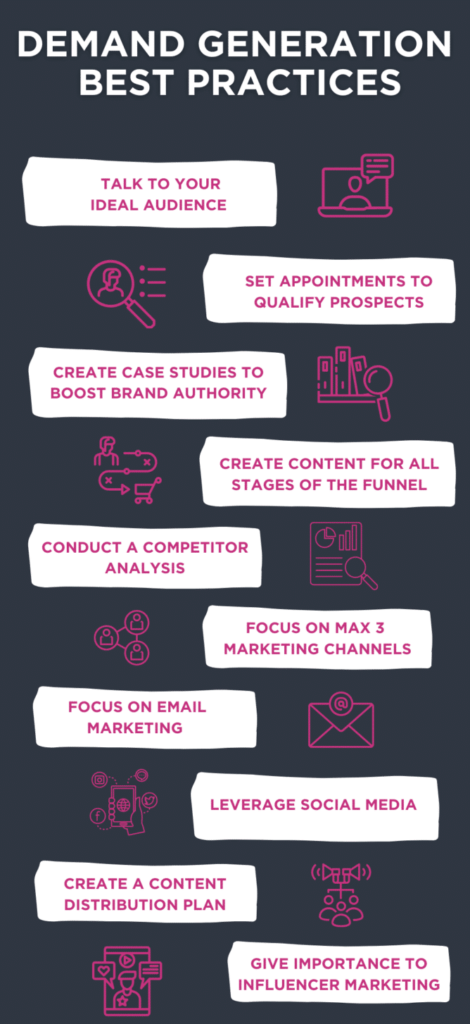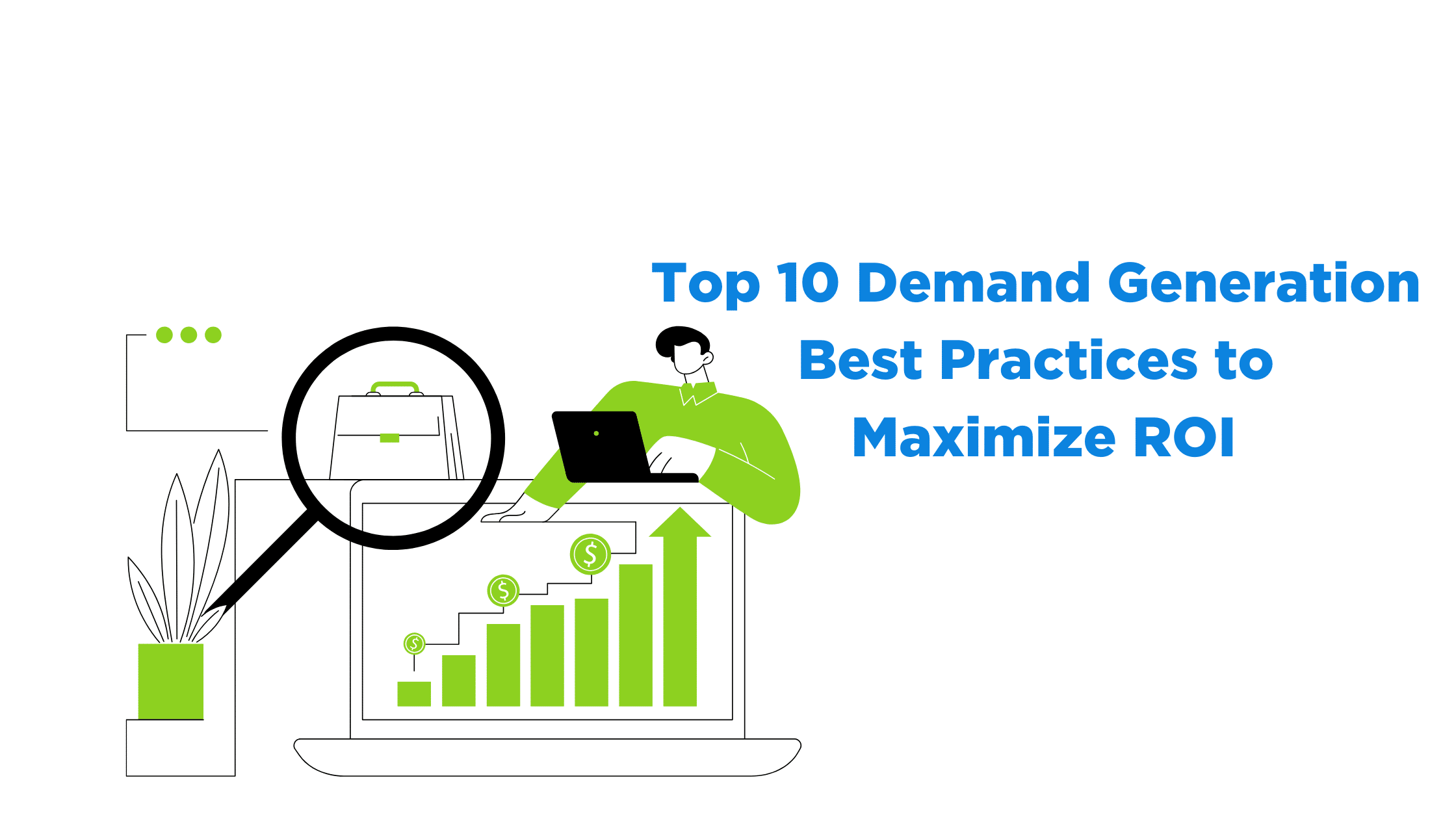Demand generation best practices are a list of actions that can enhance the demand generation process at its best. This process is all about generating demand to drive better results; there is no silver bullet technique. It takes an in-depth understanding and research of your target audience and their challenges. Demand generation is a thoughtful marketing technique from pin-point planning to execution and optimization.
We are here with the top ten best practices if you are looking for some starting point to shape your demand generation campaigns and drive them in the right direction. These can help you build a solid demand generation campaign to maximize the results for better growth and revenue. Let’s get right into it.
Table of Contents
- Demand Generation’s Role in Improving Your ROI
- Demand Generation Best Practices
- Frequently Asked Questions
- Time To Implement Demand Generation Best Practices
- Related Reads
Demand Generation’s Role in ROI
According to Forbes, an annual ROI of 7% or more is considered good. Before analyzing the benefits of a demand-generating process on the business, let us clarify what ROI is. Return on Investment (ROI) is more like the profit a business gains from the capital invested. Thus, boosting ROI is the ultimate goal of any business.
Generating demand can considerably increase brand value and put them in the spotlight. This process can eventually build trust among the audience and simplify the process of converting them into customers. Generating demand is the base of bringing in customers and can positively impact the ROI.
Demand Generation Best Practices
Having a checklist to verify if we are following the right steps in the right way helps people to ensure the quality of the outcomes. Likewise, if you have a Demand Generation Best Practices list to check the effectiveness of the process, the chances are high for you to meet the best results.

1. Talk to Your Ideal Audience
Customer research is a key factor when it comes to demand generation, and that is why the best way to understand your potential customers is by directly talking to them. You can speak with the people that align with your target audience or schedule calls/interviews with your existing loyal customers to make an ideal customer persona.
Ask them about their challenges and pain points, content, preferred channels, and what they like/dislike about your products/services. This will help you identify the content you can produce on different marketing channels for your demand-generation campaigns to get more reach.
2. Set Appointments to Qualify Prospects
Appointment setting is the need of the hour. When a prospect shows signs of interest or enters the sales funnel, marketers or appointment setters should proactively set up an appointment to qualify them.
This helps you focus on the right prospects. Once qualified, you can connect the prospects further with the sales executives so that they can close deals. It is an important part of demand generation as the appointment setter can guide the prospect and tell them how your brand can be a good fit for them.
3. Create Case Studies to Boost Brand Authority
Case studies share customers’ success stories who have benefited from using your products/services. As demand generation involves creating interest and awareness among the target audience, case studies are great.
The case studies are social proof for convincing your audience that you are trustworthy. This also helps you become an authority figure in your niche and underpins your SEO efforts. Pull out the results and stats, and take quotes from the clients to pin them on your website, product pages, and social media pages.
4. Create Content for All Stages of the Funnel
Content that engages and educates your target audience and prospects in each stage of the sales and marketing pipeline is crucial for demand-generation campaigns. You need to diversify your focus instead of using a sales-pushy tone.
Produce content ideas about potential problems, helpful solutions, product awareness, product comparisons, expert opinions, and case studies. You need to have content for people who are just entering your funnel, prospects who are interested, and qualified prospects (opportunities) that are close to buying your product (needs a little bit of convincing).
5. Conduct a Competitor Analysis
Keeping tabs on your competitors is a great practice to find out what they are doing to boost brand awareness and generate demand. This can help you identify the opportunities you might be missing out on.
So, look at the content they are creating, how they are distributing it, what is unique about their content strategy, how they engage with the audience, what channels they are mainly active on, and so on. Then compare this with your demand generation strategies and techniques to find how you can further optimize your campaigns.
6. Focus on max 3 Marketing Channels
Demand generation is all about quality, and when you try to be everywhere, your target audience is, you reduce your chances of driving the best results from a single channel. So, simultaneously focusing on 1-3 marketing channels is a better practice.
Create content for particular channels and focus on those channels only for a specific campaign. If you want to try out different channels to see how your content and engagement strategies work on other platforms, you can do that in the next campaign. So, try to be consistent on limited channels to maximize the results.
7. Focus on Email Marketing
Email marketing isn’t going anywhere, and 87% of marketers use this channel to distribute their content, making it the second most preferred content distribution channel. This shows how highly effective it can be for your demand-generation ventures.
You can personalize the emails and spread brand awareness using this channel to connect with your prospects. Make your emails more responsive and even provide the “opt-out” option to the subscribers to see which audience is reacting in which way to your content. This can help you drive quality leads into the sales pipeline.
8. Leverage Social Media
Optimizing your social media and leveraging the true potential of this powerful marketing channel is the perfect way to boost demand and revenue. How so? Social media helps you stay in front of the audience with informative and engaging content.
Quick communication lets you discover and engage with quality prospects and easily generate leads. Moreover, social media platforms allow you to interact with potential prospects through stories and comments, which helps build a better presence and strong relationships.
9. Create a Content Distribution Plan
Creating quality content and publishing it on your website or social media is just half the battle. The other half efficiently distributes it on relevant platforms at perfect timing to boost demand and capture leads.
You need to distribute your content on platforms where your audience is more likely to see it. Convert your blogs into short snippets and infographics and share them over social media with links to the entire blog. Similarly, you can trim your videos into short clips and use them on your website or social channels to effectively engage more audiences.
10. Give Importance to Influencer Marketing
Influencer marketing is great and effective for your demand-generation campaigns in many ways. Firstly, you build social proof for your business, increasing trust; secondly, you can reach a broader target audience through collaboration with relevant influencers.
So, start identifying your industry-relevant influencers and reach out to them with a collaboration opportunity. Then you can host webinars, feature in their story or post, and get mentioned in a blog or article. You can develop any creative idea according to your budget and communicate with the influencer.
Frequently Asked Questions
1. How does the Demand Generation Process Affect ROI?
Putting your product or service in the limelight and taking it closer to the right audience will increase the likelihood of having more customers. Enriching the sales pipeline with quality customers will increase the revenue of the business if done properly.
2. Is demand generation different from lead generation?
Most people might misunderstand one for the other. There is a thin yet prominent difference between these two terms. Demand generation is the steps taken to create interest among their target audience. In comparison, the other one commonly refers to the sequential approach of converting the leads into customers.
3. What are the top 3 demand-generation techniques?
There are a bunch of techniques for an effective demand-generating process. The top ones include:
Grabbing a wider range of audiences through catchy social media posts.
Creating content for audiences of all sales funnel levels.
Running an effective and well-researched email marketing campaign.
Time to Implement the Demand Generation Best Practices to Boost ROI
One important thing we can summarize from these demand generation best practices is that it is crucial to understand the audience and provide them with ultimate value. Build your position as an industry leader, which will eventually help you drive demand and brand awareness.
Most importantly, focus on your audience, prospects, and customers instead of your brand to build solid relationships. If you still feel that you need a more reliable and better demand generation work frame, you can reach out to our team to take your business to new heights with our demand generation services.
Related Posts:
- Demand Generation – The Ultimate Guide with 9 Proven Strategies
- Lead Generation vs Demand Generation
Illustration: Storyset



